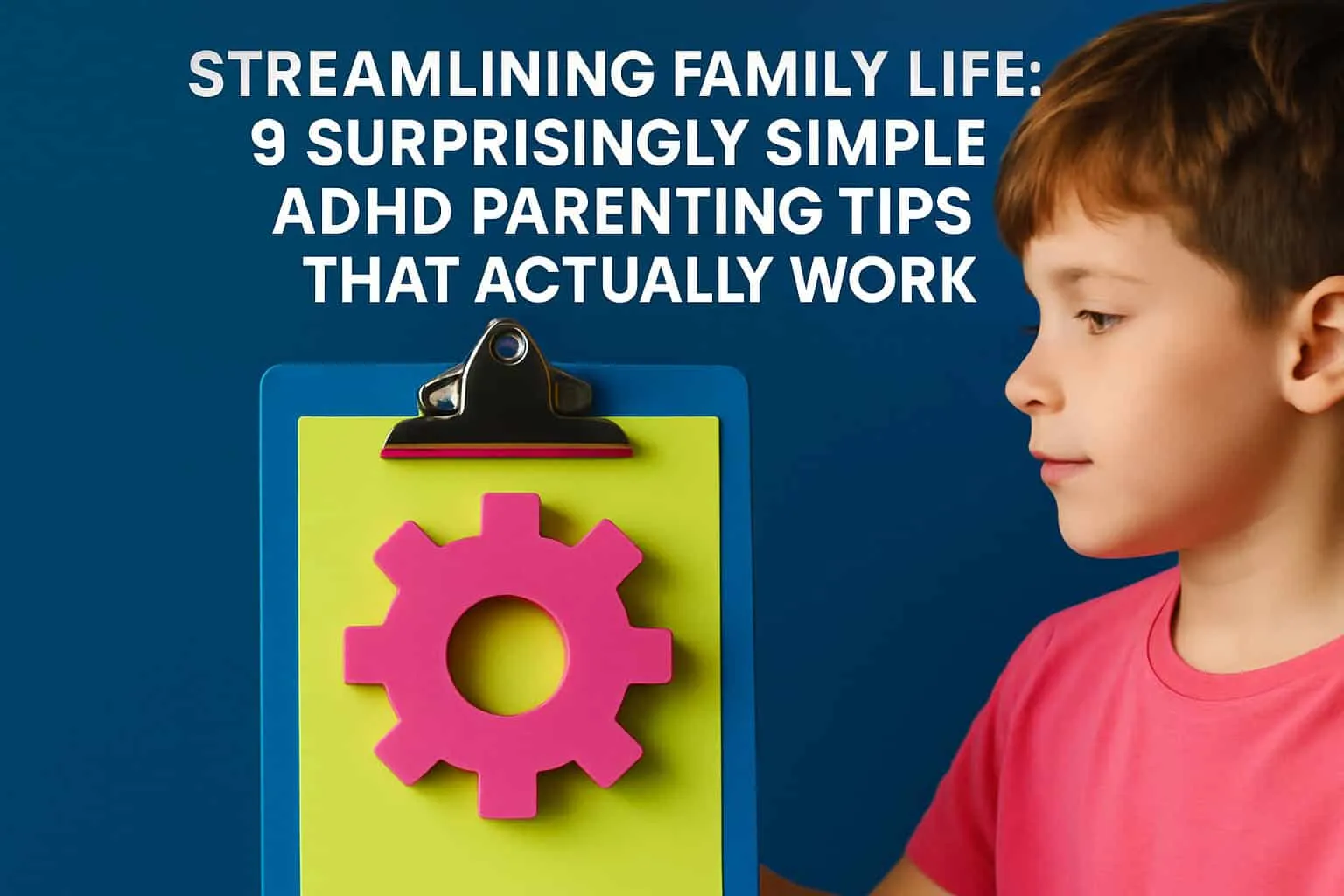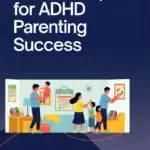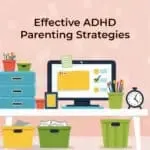If you’ve ever typed "practical tips for parenting with adhd" into a search bar at 2 a.m. while reheating yesterday’s coffee, you’re in the right place. We're Heidi and Holger - the duo behind The Simple Balance - and we know what it’s like to juggle three kids, multiple blogs, and a household where ADHD quirks aren’t just footnotes; they’re chapter titles. Together we’ll unpack nine ridiculously doable strategies that tame chaos, free up time, and help you reclaim those golden family moments without adding complicated routines or guilt-trips.
In our experience with ADHD parenting, simplicity is key. This guide offers essential insights for effective ADHD parenting.
Ready to swap frantic mornings for smoother sailing? Let’s dive into why simplifying is the secret sauce for ADHD families and how each tip can fit seamlessly into your everyday life in Germany, the U.S., or wherever you call home.

Why Simplicity Matters for ADHD Families
The following tips are tailored for ADHD parenting, ensuring you can implement them without overwhelming your family.
From our dining room to yours, we’ve crafted these tips with ADHD parenting in mind. They reflect our experiences as ADHD parenting advocates.
Research suggests that households with one or more ADHD members experience more micro-decisions per day - tiny choices like “Where are my keys?” or “What’s for lunch?” These mental speed-bumps drain executive function faster than your phone battery on roaming, leading to decision fatigue (Psychology Today, 2024).
The Simple Balance exists because we hit that wall themselves. Between school runs and blog deadlines, we found that trimming steps - not adding new ones -was the key to sanity. By focusing on simple approaches (think two-step routines and visual cues) and sharing time-saving recipes, we try to help families like ours shift from survival mode to what Germans call Feierabend - that lovely feeling when work is done and life can begin.
Below you’ll find nine tools that work precisely because they’re uncomplicated. Each tip removes friction, respects the ADHD brain’s need for novelty, and still leaves room for spontaneous pillow forts.
Practical Tips for ADHD Parenting: The 9 Game-Changers
The following list reads a bit like a conversation around our dining room table - tomato stains and all. Each tip includes a quick “Why it Works” blurb backed by data or real-world results from the ADHD community.
1. The Two-Minute Tidy
The Two-Minute Tidy is an effective strategy we’ve embraced in ADHD parenting. It encourages teamwork and quick results.
What it is: A family-wide sprint where everyone tackles one hotspot for exactly 120 seconds - no more, no less.
Why it works: According to Dr. Ari Tuckman, short bursts beat marathon cleaning sessions for ADHD brains because they sidestep overwhelm. A timer provides urgency and a clear finish line, while the mini-win releases dopamine, nature’s built-in high-five.
- Choose a song under two minutes (kids love guessing when it will end).
- Assign micro-tasks: shoes in the rack, Legos in the bin, mail in one pile.
- Celebrate visibly - think air-high-fives or a silly victory dance.
2. Visual Schedules Everywhere
Visual schedules are a game changer in ADHD parenting. They help children understand their daily routines better.
What it is: Picture-based routines posted at crucial points: bathroom mirrors, the fridge, and the front door.
Why it works: Visual cues reduce verbal nagging, and people with ADHD need frequent cues, according to researchers (e.g. Journal of Childhood & Developmental Disorders, 2017). Kids can see “brush teeth” or “pack lunch” instead of relying on memory (or Mom’s third reminder).
Pro-tip: Laminate checklists, then use dry-erase markers so tasks feel fresh each morning.
3. Snack Stations
Implementing snack stations is another practical approach we recommend for ADHD parenting. It fosters independence in kids.
What it is: A low shelf stocked with pre-portioned fruit, cheese, and other snack options that kids can grab whenever hunger hits.
Why it works: ADHD medication often leads to reduced appetite - until it stops working. Intuitive eating empowers kids to notice hunger signals instead of waiting for set meal times.
Bonus: It frees you from being the household snack concierge.
4. Color-Coding Is Your Co-Pilot
Color-coding can streamline ADHD parenting. It helps identify personal items quickly, reducing frustration.
What it is: Assign each family member a color for towels, toothbrushes, water bottles, and calendar entries.
Why it works: Studies show that color tags speed object retrieval by between 10 and 30%. Less searching equals fewer late buses and less cortisol all around.
Pro tip: neon duct tape on phone chargers eliminate many “That’s mine!” debates.
5. The Five-Item Rule for Decluttering
The Five-Item Rule can simplify clutter management in ADHD parenting. Small tasks accumulate to a significant impact.
What it is: Each evening, every person removes or donates just five stray items.
Why it works: Momentum. Five feels small, but over a month that’s 150 items gone, enough to empty a closet without dedicating a weekend.
| Family Size | Daily Items Removed | Monthly Total |
|---|---|---|
| 2 | 10 | 300 |
| 4 | 20 | 600 |
| 5 | 25 | 750 |
6. Timers Are Your Personal Coaches
Timers serve as helpful reminders in ADHD parenting. They create structure and encourage on-task behavior.
What it is: Kitchen timers, phone alarms, or the family favorite, Alexa timers.
Why it works: Time blindness makes five minutes feel like thirty (or vice versa). External timers anchor tasks, preventing hyper-focus rabbit holes and last-minute scrambles.
Try “20 on, 10 off” learning sessions. Kids get built-in breaks, and you can spend some quality time during the pause (especially if you stagger the start times, so only one of them is on their break at all times).
7. The Bedtime Basket Hack
The Bedtime Basket is a practical tool for ADHD parenting. It prepares children for smoother mornings.
What it is: A crate beside each child’s bed holding tomorrow’s outfit, favorite book, and fidget toy.
Why it works: Nighttime preparation reduces morning decision fatigue. That way, not much thinking and decision-making needs to happen during the morning hours when everyone is only half-awake anyway.
Tip: Let kids curate the basket to boost autonomy and buy-in.
8. Weekly Family Brain Dump
Weekly family brain dumps foster communication and understanding in ADHD parenting. It’s a helpful practice for everyone.
What it is: Ten minutes every Friday where everyone blurts out tasks or worries onto sticky notes.
Why it works: Offloading thoughts clears mental clutter. When parents model this, kids learn self-regulation. Grouping notes into “Do,” “Delegate,” and “Delete” transforms chaos into a plan.
9. Sunday Reset with Recipe Batching
Sunday resets with recipe batching simplify mealtime planning in ADHD parenting. Meals become effortless and enjoyable.
What it is: One hour on Sunday prepping three base foods - a protein, some vegetables, and a source of carbs.
Why it works: Recipe batching slashes weeknight cooking time in half. Having building blocks on hand keeps dinners flexible - no strict meal plans required. Just add some variety by using different sauces or swapping in a tortilla to turn a rice dish into a burrito.
Favorite combo: roast chicken, cut up raw vegetables (bell peppers, tomatoes, cucumber, carrots) that can be eaten both raw and cooked, and a big pot of pasta. Mix and match all week by adding tomato puree, sweet and sour sauce, etc.
How This Fits Into Your Routine
This post contains a field-tested toolbox forged in the real-life laboratory of a German family with ADHD. Below is a quick look at how our methods stack up against common complicated routines.
| Area | Typical Approach | The Simple Balance Way | Time Saved/Stress Reduced |
|---|---|---|---|
| Morning Prep | Multiple verbal reminders, last-minute outfit hunts | Bedtime Basket + Visual Schedule | 15 min less chaos |
| House Cleaning | Weekend marathon sessions | Two-Minute Tidies daily | Energy spread evenly; fewer complaints |
| Meal Times | Daily recipe decisions, grocery runs | Sunday Reset + Snack Station | 4–5 hours weekly |
| Mental Load | Parents hold all tasks in their heads | Weekly Brain Dump visible to all | Lower parental burnout |
Notice a pattern? Simpler steps, visible systems, and shared responsibility equal more breathing room. That freed-up bandwidth can go toward quality time, listening to that 30-minute Minecraft braindump your son unleashes on you, or just sitting down with a cup of coffee that’s actually hot.
ADHD Parenting Quick-Reference Cheat-Sheet
| # | Tip | Main Tool | Daily Time Required | Biggest Benefit |
|---|---|---|---|---|
| 1 | Two-Minute Tidy | Phone timer + upbeat song | 2 min | Visual calm |
| 2 | Visual Schedules | Laminated icons | 0 min after setup | Fewer reminders |
| 3 | Snack Station | Low shelf bins | 5 min restock | Stable energy |
| 4 | Color-Coding | Tape & markers | 10 min initial | No mix-ups |
| 5 | Five-Item Rule | Collection box | 3 min | Less clutter |
| 6 | Timers | Hourglass / alarm | Varies | On-task focus |
| 7 | Bedtime Basket | Small crate | 5 min nightly | Calmer mornings |
| 8 | Family Brain Dump | Sticky notes | 10 min weekly | Mental clarity |
| 9 | Sunday Reset | Containers | 60 min | Effortless meals |
By incorporating these strategies, ADHD parenting can shift from overwhelming to manageable, ensuring every family member thrives.
Conclusion
Nine tips, one common thread: simplicity beats complexity every single school morning, grocery run, and homework hour. By folding in two-minute sprints, color-coding, snack stations, and other streamlined tactics, you’ll protect the most precious family resource - time. When routines are trimmed to their elegant essentials, ADHD quirks shift from stumbling blocks to stepping stones. Keep it simple, keep it visible, and watch family life glide from frantic to fulfilling.


